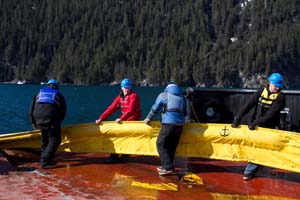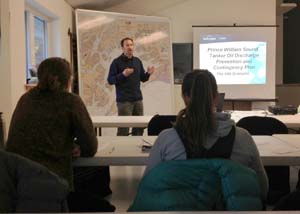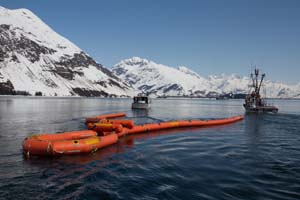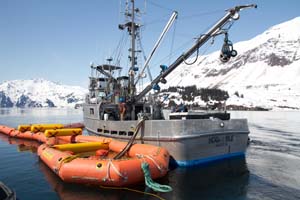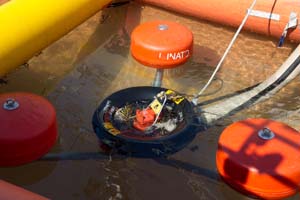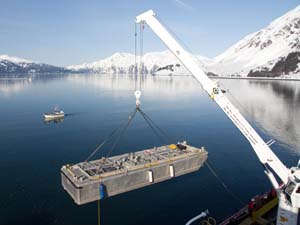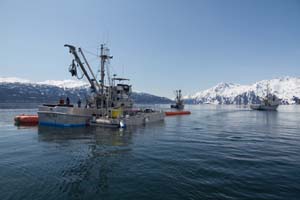Remote controlled unmanned aircraft, commonly known as “drones,” have been approved by the Federal Aviation Administration for use in Alaska. Conoco Phillips received the approval to use the drones to monitor for oil spills and observe wildlife off the Beaufort Sea coast in the Arctic Circle.
Online Observer
Working together effectively is a matter of balance and finding the middle road
By MARK SWANSON
Council Executive Director

Almost every issue of significance comes to us with strongly divergent viewpoints. In the oil transportation industry, for example, some say more regulations are needed while others say less regulations would be better. Often we as human beings dismiss a view opposite our own. Today, people have the opportunity to segregate and isolate themselves to a great extent. They may have little occasion to associate with others or be exposed to information about differing viewpoints or beliefs. With political re-districting, politicians in the majority party get to pick their voters instead of voters picking their politicians. These tendencies can lead to increasingly polarized viewpoints on the issues that affect us all. We are losing the ability to find common ground and mentally stand in the other person’s shoes enough to see balanced viewpoints. Combine these trends with winner take all style elections and decisions by authority figures and we end up with hostile and marginalized losers and arrogant and callous winners on virtually every issue. Eventually, when things get so lopsided that the pendulum swings the other way, it is often abrupt and disruptive. This is neither good nor sustainable.
Council strives to find middle ground
The council aims to come up with sound advice and reasonable solutions that are balanced and benefit a broad collection of stakeholders with disparate views, all affected by the environmentally safe operation of Alyeska’s terminal and tankers. For example, the council would like to see the risk of oil spills from previously uninspected piping or crude oil tanks at the terminal eliminated or at least reduced to a level as low as reasonably practicable. Currently, the terminal’s pipe and tank inspections are expensive and disrupt operations. However, oil spills are also expensive, disrupt operations, and damage reputations. The council has recommended the application of industry and regulatory best practices as a balanced tried and true solution to address these intersecting concerns and balance cost with benefits.
Often there is no tried and true answer. Finding a solution can be difficult. Sometimes, as a mental exercise, simply articulating the extremes that neither side would advocate for helps to paint a path and better define the middle ground where a consensus or acceptable compromise can be found. Another method is a robust exposure to and familiarity with the opposing view holders’ concerns. Based on who we work for, how we were raised and other differentiating factors, some viewpoints are naturally opposed. So often we don’t really all want the same thing, at least not as a primary motivator. However, we often could accept many of the same things, preserving elements that are important to us, and letting go of our lesser concerns that are more important to other parties.
Workgroups help find a balanced solution
Workgroups are one common way to find middle ground when the workgroup’s principals are appropriate to ensure success. To achieve their intended purpose of finding a compromise, all participants in a workgroup need to share a commitment not only to participate and advocate for their own positions, but to listen, respect and make a good faith attempt to accommodate the concerns of other participants. Supervisors of work group participants, back in their own potentially more homogeneous and polarized work environments, with less exposure to and concern for divergent viewpoints, need to resist the urge to subvert that consensus building process that naturally arises among good faith workgroup participants.
Extreme solutions are fundamentally unhelpful and unsustainable. The council is looking for balanced solutions to help us and our industry and regulatory counterparts promote and ensure the environmentally safe operation of the Alyeska Marine Terminal and associated tankers. Let’s roll up our sleeves together.
Alyeska intern impressed by safe work environment
Every summer Alyeska Pipeline Service Company offers internships to college students around Alaska. This year, we asked them to share their thoughts about their time with Alyeska. Here’s an interview with Kyle Tee, who interned with the Facility Engineering team on the Valdez Marine Terminal.
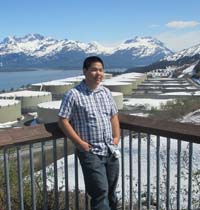
Was this your first internship on TAPS?
This is my second Internship with Alyeska. My first Internship was in Anchorage in Project Engineering.
What were your expectations for this internship when you first started?
My expectation for this internship was to learn more information about Valdez and what type of work is involved here. Accepting this internship in Valdez I knew that I would be seeing more of the pipeline and being away from a cubical a little bit more than if I was in Anchorage and I was excited for that.
What was the most interesting or educational project you worked on and why?
The most interesting project I worked on is a design of a snow shelter to access a valve. The reason why it is so interesting is because the space to place a snow shelter is very limited. There is only about 28 inches between the building and a tank and during the winter snow is falling off of the structures and building up between them. So far the design is incomplete but it has been an enjoyable experience with it.
Who is someone who really mentored you, and how did they do that?
Todd Carsten: he gave, helped and guided me on all of the projects I worked on this summer. When we go out into the field I tend to be very observant and ask a lot of questions and Todd has done an outstanding job in providing me with answers to my questions.
Tell us about one of your favorite experiences you had during the internship.
My favorite experience would be the morning that Carol and Jeff Simmons given me the opportunity to kayak to work. It was terribly early in the morning but the whole scenery was beautiful. We didn’t encounter any wildlife of any sort but it was an awesome way start off the day.
Describe what you’ve learned about the TAPS culture.
From this internship I have a greater understanding of the five cultural attributes than I had last summer. The attribute that I most identified with is Making Sound Decision. Ever since I started to work in the Valdez Terminal I have heightened my safety awareness to ensure that I am making sound decision every day when I am out in the field and everything I do.
Now that you’ve spent many weeks working on TAPS, what’s your impression of Alyeska, TAPS, or its people?
My last impression I will have of Alyeska’s will be the extraordinary safety environment that I was given the opportunity to work in this summer.
Oil spill response in Sound depends on trained fishing vessel crews
In Prince William Sound, fishing vessel crews are trained to help clean up oil spills. These trained responders are familiar with local waters, and can respond quickly to a spill.
Alyeska’s Ship Escort Response Vessel System, or SERVS, oversees the program. SERVS contracts vessels throughout Prince William Sound and downstream areas such as Kodiak, Seward, Homer, Kenai and other smaller communities as part of the program. There are over 400 vessels and their associated crews on contract.
The vessels’ crews attend three days of training each year, including classroom lectures, hands-on experience with equipment, and on-water exercises.

